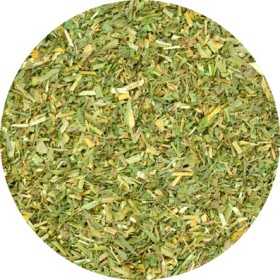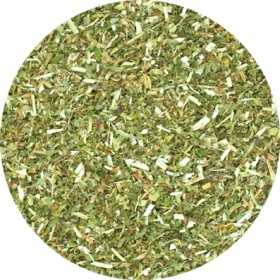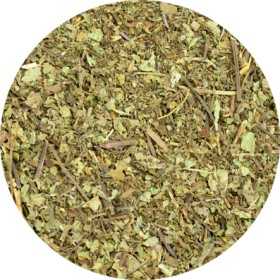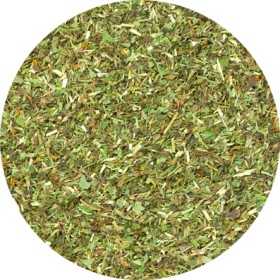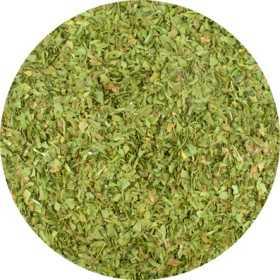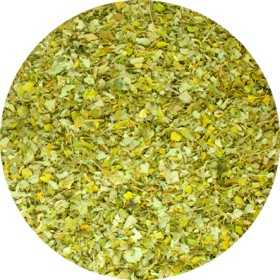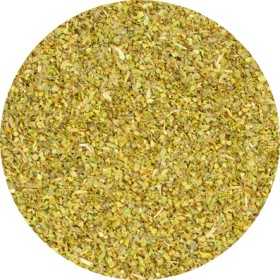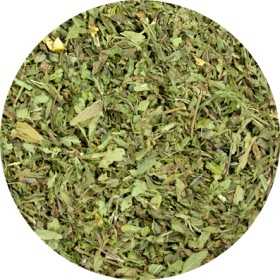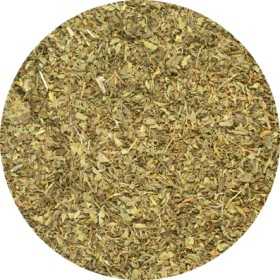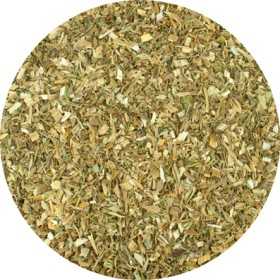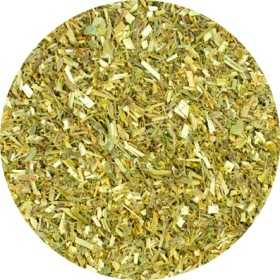K, L, M, N, O
There are 13 products.
Alfalfa - Medicago sativa
Lucerne (Medicago sativa), also known as alfalfa, is a perennial plant that can live between five and twelve years, depending on the variety and climate. With a height of up to one meter and clusters of small purple flowers, the plant resembles clover. The plant has a deep and powerful root system that can extend up to 4.5 meters.
Lucerne is native to Europe and is grown worldwide as animal feed. In the Netherlands, alfalfa is mainly dried artificially for the production of protein-rich animal feed.
Lucerne is native to Europe and is grown worldwide as animal feed. In the Netherlands, alfalfa is mainly dried artificially for the production of protein-rich animal feed.
€2.00
From: €2.00
Catnip - Nepetae catariae
Wild catnip (Nepeta cataria) belongs to a genus of 250 species in the family Lamiaceae. The genus is closely related to Glechoma, Stachys and Prunella. This genus originally occurs in Europe and Asia. The stems grow in nodes and often form dense carpets on the ground. The leaves are coarsely toothed and feel soft because of the hairs. The erect stems bear small, tubular flowers in pairs that are located in the axils of the leaves.
€2.20
From: €2.20
Heartwort - Leonurus cardiaca
Heartwort (Leonurus cardiaca) is a fragrant perennial plant that belongs to the Lamiaceae family. Originating in Central Asia, this plant has spread throughout the world.
The leaves are suitable for seasoning pea and lentil soup, and were also used in the past to brew beer. This plant has been used for centuries for its medicinal properties for heart problems and muscle cramps.
The plant grows to a height of 30-90 cm and forms rhizomes and square stems with scattered hairs. The leaves, which are medium green in color, have three to seven lobes and are downy hairy on the underside.
The leaves are suitable for seasoning pea and lentil soup, and were also used in the past to brew beer. This plant has been used for centuries for its medicinal properties for heart problems and muscle cramps.
The plant grows to a height of 30-90 cm and forms rhizomes and square stems with scattered hairs. The leaves, which are medium green in color, have three to seven lobes and are downy hairy on the underside.
€2.00
From: €2.00
Kumis Kutjing - Cat's whiskers - Orthosiphon aristatus - Cut
Cat's whisker (Orthosiphon aristatus), also known as Kumis Kutjing, has played an important role in Ayurvedic medicine for centuries due to its beneficial properties in treating urinary tract infections.
This plant belongs to the Lamiaceae family and thrives mainly in tropical and subtropical regions, preferring locations such as wetlands, along rivers and swamps, especially in Southeast Asia, especially Malaysia and Java. The name "cat's whisker" is derived from the white or lilac flowers with striking, thread-like stamens, sometimes up to 3 cm long.
This plant belongs to the Lamiaceae family and thrives mainly in tropical and subtropical regions, preferring locations such as wetlands, along rivers and swamps, especially in Southeast Asia, especially Malaysia and Java. The name "cat's whisker" is derived from the white or lilac flowers with striking, thread-like stamens, sometimes up to 3 cm long.
€4.50
From: €4.50
Lemon Balm - Melissa officinalis
Lemon balm (Melissa officinalis) is a perennial plant from the Lamiaceae family known for its lemony scent. This plant grows mainly in southern Europe, but can be easily propagated in temperate regions such as the Netherlands and Belgium, as it survives in winter via rhizomes. The plant reaches a height of about 0.5 meters.
Lemon balm has a long history; The plant was already known to various peoples 2000 years ago. The Arabs probably brought the plant to Europe via Spain, after which monasteries initially engaged in its cultivation. Ancient scriptures state that lemon balm leaves warm the stomach, aid digestion, dispel gloom and promote cheerful dreams. The leaves are often used in dishes, tea, oil or creams.
Lemon balm has a long history; The plant was already known to various peoples 2000 years ago. The Arabs probably brought the plant to Europe via Spain, after which monasteries initially engaged in its cultivation. Ancient scriptures state that lemon balm leaves warm the stomach, aid digestion, dispel gloom and promote cheerful dreams. The leaves are often used in dishes, tea, oil or creams.
€2.00
From: €2.00
Lovage - Levisticum officinale
Lovage, also known as the maggi plant, is a perennial plant from the umbellifer family (Apiaceae). The name "maggi plant" refers to the strong smell, which is reminiscent of the maggi aroma. However, the herb is not an ingredient in the original Maggi recipe.
Originally from Southeast Asia and Iran, the Romans spread lovage throughout Europe during their conquests. Today, the plant grows in large parts of Europe and North America and occasionally occurs in northern Thailand.
Originally from Southeast Asia and Iran, the Romans spread lovage throughout Europe during their conquests. Today, the plant grows in large parts of Europe and North America and occasionally occurs in northern Thailand.
€3.50
From: €3.50
Moringa Tree - Moringa oleifera - (Leaf Cut)
Moringa oleifera, also known as the 'tree of life', thrives in Africa and Asia and is known for its rich nutritional value. The tree is a treasure trove of over dozens of nutrients, including as many as 47 antioxidants. With minerals, proteins, vitamins, beta-carotene, amino acids and various phenols in abundance, the leaves of the moringa are the true storehouse of nutritional value.
For centuries, Asian and African cultures have recognized the benefits of moringa oleifera. The tree has become an integral part of their daily diets due to its versatile uses and nutritional value. Due to its abundant benefits, moringa oleifera is often affectionately called 'the tree of life'.
For centuries, Asian and African cultures have recognized the benefits of moringa oleifera. The tree has become an integral part of their daily diets due to its versatile uses and nutritional value. Due to its abundant benefits, moringa oleifera is often affectionately called 'the tree of life'.
€2.95
From: €2.95
Olive - Olea europaea
Olive leaves, from the wild olive tree (Olea europaea), are naturally rich in antioxidants. Originally native to western Asia, Egypt and Syria, these trees are now a distinctive sight throughout the Mediterranean region, as well as in regions such as South America, the southern United States, southern Australia and the tropics. Olive leaf tea has been consumed in the Mediterranean for centuries, and this is not surprising given the known antioxidant properties of olive leaves. It is therefore no coincidence that the olive tree is often referred to as the 'tree of life'.
€2.25
From: €2.25
Oregano - Origani vulgaris
Oregano (Origanum vulgare) also known as wild marjoram, is a special herb that has been used for thousands of years for its beneficial properties. It supports healthy intestinal flora and promotes digestion. In addition, oregano has benefits for the heart, blood vessels and blood pressure.
The herb belongs to the Lamiaceae family, which also includes rosemary, thyme and mint. Oreganois is particularly rich in carvacrol, which gives it its characteristic spicy and slightly bitter taste. The most vigorous form of oregano grows in Mediterranean mountain areas, thriving on calcareous soil. During the spring, wild oregano blooms and residents go into the mountains to collect these aromatic herbs.
The herb belongs to the Lamiaceae family, which also includes rosemary, thyme and mint. Oreganois is particularly rich in carvacrol, which gives it its characteristic spicy and slightly bitter taste. The most vigorous form of oregano grows in Mediterranean mountain areas, thriving on calcareous soil. During the spring, wild oregano blooms and residents go into the mountains to collect these aromatic herbs.
€2.80
From: €2.80
Peppermint - Menthae piperita
Peppermint (Mentha piperita) is often taken to support digestion. Peppermint is a member of the Lamiaceae family and is used for making peppermint candy.
In herbal medicine, peppermint has a long history dating back to ancient Greece. There, the fragrant peppermint leaf was traditionally used to aid digestion. Peppermint contains several essential oils, including menthol, menthone and cineole.
Peppermint originated from a cross between water mint (Mentha aquatica) and spike mint (Mentha spicata). In the seventeenth century, this plant was discovered in England in a field with mint plants.
In herbal medicine, peppermint has a long history dating back to ancient Greece. There, the fragrant peppermint leaf was traditionally used to aid digestion. Peppermint contains several essential oils, including menthol, menthone and cineole.
Peppermint originated from a cross between water mint (Mentha aquatica) and spike mint (Mentha spicata). In the seventeenth century, this plant was discovered in England in a field with mint plants.
€2.00
From: €2.00
Spearmint - Mentha spicata
Spearmint, also known as green mint (Mentha spicata), is an aromatic perennial plant from the Lamiaceae family. This plant originally comes from Central and Southern Europe, where it regularly establishes itself as a feral plant. Peppermint (Mentha ×piperata), a commonly used variety in food and care products, originated from a cross between spearmint and water mint (Mentha aquatica).
The leaves of spearmint contain a wealth of essential oils, with carvone being the most important. This component is also found in caraway, which gives the mint its characteristic scent. However, the leaves contain little menthol, which makes the taste milder than that of peppermint.
The leaves of spearmint contain a wealth of essential oils, with carvone being the most important. This component is also found in caraway, which gives the mint its characteristic scent. However, the leaves contain little menthol, which makes the taste milder than that of peppermint.
€2.00
From: €2.00
Watercress - Nasturtium officinale
The watercress (Rorippa nasturtium-aquaticum, synonym: Nasturtium officinale) is a plant from the cruciferous family (Brassicaceae). This species is very similar to the slender watercress (Rorippa microphylla), but is distinguished by shorter fruits, seeds that lie in two rows in each cell instead of one, and a seed structure with about half as many meshes.
The white watercress grows in and around water, such as along streams, ditches, ponds and in marshes. It is a limp, hairless plant that can reach a height of 10 to 60 cm. The hollow, square, fleshy stem often creeps at the base.
The white watercress grows in and around water, such as along streams, ditches, ponds and in marshes. It is a limp, hairless plant that can reach a height of 10 to 60 cm. The hollow, square, fleshy stem often creeps at the base.
€3.75
From: €3.75
Yellow Sweet Slover - Melilotus officinalis
The Yellow Sweet Slover (Melilotus officinalis) is a biennial or perennial plant from the legume family (Leguminosae). Originally from Southern Europe, this plant has now spread worldwide. It is a slender, hairless plant that is frequently found along roads and on arable land, and is also found in dune areas. The lemon yellow honey clover reaches a height of 30 to 150 cm and blooms from July to October.
€2.00
From: €2.00















